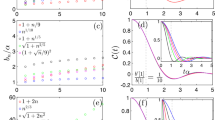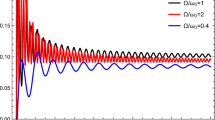Abstract
The various approaches to nonequilibrium statistical mechanics may be subdivided into convolution and convolutionless (time-local) ones. While the former, put forward by Zwanzig, Mori, and others, are used most commonly, the latter are less well developed, but have proven very useful in recent applications. The aim of the present series of papers is to develop the time-local picture (TLP) of nonequilibrium statistical mechanics on a new footing and to consider its physical implications for topics such as the formulation of irreversible thermodynamics. The most natural approach to TLP is seen to derive from the Fourier-Laplace transform\(\widetilde{C}(z)\)) of pertinent time correlation functions, which on the physical sheet typically displays an essential singularity at z=∞ and a number of macroscopic and microscopic poles in the lower half-plane corresponding to long- and short-lived modes, respectively, the former giving rise to the autonomous macrodynamics, whereas the latter are interpreted as doorway modes mediating the transfer of information from relevant to irrelevant channels. Possible implications of this doorway mode concept for socalled extended irreversible thermodynamics are briefly discussed. The pole structure is used for deriving new kinds of generalized Green-Kubo relations expressing macroscopic quantities, transport coefficients, e.g., by contour integrals over current-current correlation functions obeying Hamiltonian dynamics, the contour integration replacing projection. The conventional Green-Kubo relations valid for conserved quantities only are rederived for illustration. Moreover,\(\widetilde{C}(z)\) may be expressed by a Laurent series expansion in positive and negative powers ofz, from which a rigorous, general, and straightforward method is developed for extracting all macroscopic quantities from so-called secularly divergent expansions of\(\widetilde{C}(z)\) as obtained from the application of conventional many-body techniques to the calculation of\(\widetilde{C}(z)\). The expressions are formulated as time scale expansions, which should rapidly converge if macroscopic and microscopic time scales are sufficiently well separated, i.e., if lifetime (“memory”) effects are not too large.
Similar content being viewed by others
References
S. Nakajima,Progr. Theor. Phys. (Kyoto) 20:948 (1958).
R. Zwanzig,J. Chem. Phys. 33:1338 (1960);Physica 30:1109 (1964).
F. Haake,Springer Tracts in Modern Physics, No. 66 (1973), p. 98.
H. Mori,Progr. Theor. Phys. (Kyoto) 33:423 (1965).
B. Robertson,Phys. Rev. 144:151 (1966);153:391 (1967); inThe Maximum Entropy Formalism, R. D. Levine and M. Tribus, eds. (MIT Press, Cambridge, Massachusetts, 1979).
H. Grabert,Springer Tracts in Modern Physics, Vol. 95 (1982).
E. Fick and G. Sauermann,Quantenstatistik dynamischer Prozesse (Geest & Portig, Leipzig, 1983).
C. Truesdell,Rational Thermodynamics (McGraw-Hill, New York, 1969).
A. Fulinksi and W. J. Kramarczyk,Physica 39:575 (1968); A. Fulinski,Phys. Lett. 35A:13 (1967);Physica 92A:198 (1978).
A. R. Altenberger and J. Stecki,J. Stat. Phys. 5:83 (1972).
T. Shimizu,J. Phys. Soc. Jpn. 28:1088 (1970).
M. Tokuyama and H. Mori,Progr. Theor. Phys. 55:411 (1976);56:1073 (1976);58:92 (1977).
M. Tokuyama,Physica 102A:399 (1980);109A:128 (1981);113A:350 (1981).
N. Hashitsume, F. Shibata, and M. Shingu,J. Stat. Phys. 17:155 (1977).
F. Shibata, Y. Takahashi, and N. Hashitsume,J. Stat. Phys. 17:171 (1977).
F. Shibata and N. Hashitsume,J. Phys. Soc. Jpn. 44:1435 (1978);Z. Phys. B 34:197 (1979).
H. Furukawa,Progr. Theor. Phys. Jpn. 62:70 (1979).
F. Shibata and T. Arimitsu,J. Phys. Soc. Jpn. 49:891 (1980).
M. Frankowicz,Z. Phys. B 43:251 (1981).
Y. Hamano and F. Shibata,J. Phys. Soc. Jpn. 51:1727,2085 (1982).
R. Der,Phys. Lett. 92A:68 (1982).
M. Saeki,J. Phys. Soc. Jpn. 52:4081, 4091 (1983).
S. Mukamel,Phys. Rev. Lett. 42:168 (1979);J. Chem. Phys. 70:5843 (1979);Adv. Chem. Phys. 47:509 (1981);Phys. Rev. B 25:830 (1982).
S. Mukamel,Chem. Phys. 37:33 (1979).
S. Mukamel,J. Stat. Phys. 27:317 (1982);30:179 (1983).
J. Nieuwoudt and S. Mukamel,J. Stat. Phys. 36:677 (1984).
S. Mukamel,Phys. Rep. 93:1 (1982).
S. Mukamel and D. Grimbert,Opt. Commun. 40:421 (1982).
A. Royer,Phys. Rev. A 6:1741 (1972);22:1625 (1980);J. Math. Phys. 24:380 (1983).
R. Balescu,Equilibrium and Nonequilibrium Statistical Mechanics (Wiley, New York, 1975).
S. Mukamel,J. Stat. Phys. 30:179 (1983).
H. Mori, T. Morita, and K. T. Mashiyama,Progr. Theor. Phys. 63:1865 (1980).
S. Chaturvedi and F. Shibata,Z. Phys. B 35:297 (1979).
S. Chaturvedi,Z. Phys. B 51:271 (1983).
R. Kubo,J. Math. Phys. 4:174 (1963).
N. G. van Kampen,Physica 74:215, 239 (1974).
R. F. Fox,J. Math. Phys. 20:2467 (1979);Phys. Rep. 48C:179 (1978).
R. F. Fox,Phys. Lett. 94A:281 (1983).
L. Garrido and J. M. Sancho,Physica 115A:479 (1982).
R. Der,ZfI-Mitteilungen, Vol. 79 (1983).
R. Der,Physica 132A:47 (1985).
B. J. Berne, inStatistical Mechanics, Part B, B. J. Berne, ed. (Plenum Press, New York, 1977).
D. Forster,Hydrodynamic Fluctuations, Broken Symmetry and Correlation Functions (Benjamin, Reading, Massachusetts, 1975).
R. Der and C. Webers,Physica 132A:94 (1985).
H. D. Zeh,Lecture Notes in Physics, Vol. 200 (1984), p. 36.
L. S. Garcia-Colin, M. Lopez de Haro, R. F. Rodriquez, J. Casas-Vázquez, and D. Jou,J. Stat. Phys. 37:465 (1984).
I. Prigogine,Non-Equilibrium Statistical Mechanics (Interscience, New York, 1962).
Yu. L. Klimontovich,Kinetic Theory of Nonideal Gases and Plasmas (Nauka, Moscow, 1975).
D. Jou, J. E. Llebot, and J. Casas-Vázquez,Phys. Rev. A 25:508 (1982), and references therein.
E. T. Whittaker and G. N. Watson,A Course of Modern Analysis (Cambridge University Press, 1962).
I. I. Priwalow,Einführung in die Funktionstheorie (B. G. Teubner, Leipzig, 1969), §2.8.
B. Grigolini and F. Marchesoni,Adv. Chem. Phys. LXII:29 (1986).
R. Der and W. Schumacher, in preparation.
Author information
Authors and Affiliations
Rights and permissions
About this article
Cite this article
Der, R. The time-local view of nonequilibrium statistical mechanics. I. Linear theory of transport and relaxation. J Stat Phys 46, 349–389 (1987). https://doi.org/10.1007/BF01010350
Received:
Revised:
Issue Date:
DOI: https://doi.org/10.1007/BF01010350




